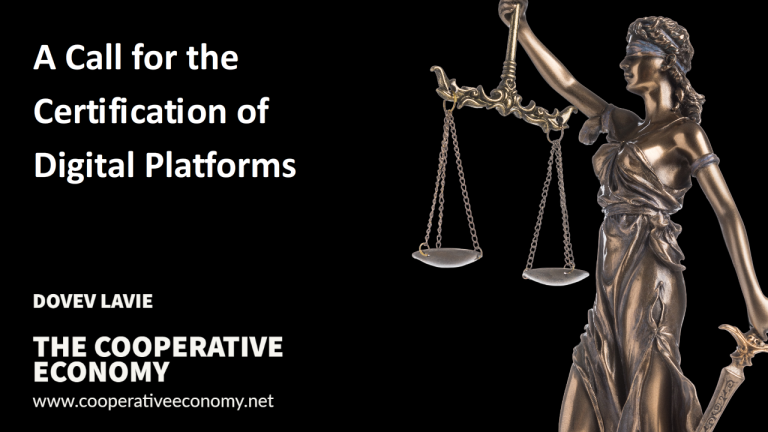Concerns are rising about the perfect storm that brings together dominant digital platforms and national politics. Europe has been relying on regulation to protect against the winds of platform harm, but regulation has reached its limits. How can we withstand the Big Tech and Chinese upstarts? How can we build digital platforms that better serve society without undermining innovation?
Instead of resorting to the familiar toolkit, I suggest a new approach. Voluntary certification of digital platforms can restrict the harmful practices of some dominant platforms but more importantly motivate contender platforms with stakeholder-oriented business models.
We do not expect all dominant platforms to forgo exploitative business models and pursue certification, but certification can reward the virtuous conduct of emerging platforms such as Mastodon, Thrive Market, Brightly, Signal, and Jitsi Meet. Before pursuing my PhD at Wharton, back in the 1990s I was a consultant for companies undergoing ISO9001 certification. I had to convince executives that their investment would pay off and that this seal of approval would attract customers and grow their business. Nowadays with more than a million certified sites, ISO9001 is needed to play, but those who were early to certify gained a differentiation advantage, much like certification of digital platforms can offer to emerging platforms today.
By complementing protective regulation with a system that motivates platforms to better serve stakeholders, contender platforms can leverage the differentiation advantage and reputation ascribed to certification. The purpose is to motivate and reward contender platforms that align their practices with the public interest. Eventually, those undergoing certification can impose competitive pressure also on some dominant platforms that may revise their practices to retain or regain market share.
What is the idea behind voluntary certification? This approach involves setting standards for desirable practices and identifying undesirable practices using scorecards to help assess and benchmark digital platforms. The inspection would be carried out by an independent third-party organization with relevant expertise, resources, and inspection processes to scrutinize the inner working of platforms.
Certification can be useful when regulation is extensive but ambiguous and difficult to enforce. A credible system for verifying the claims of those that strive to serve their stakeholders calls for authenticating their ethical conduct. Certification can validate practices to ensure their compliance with standards, as in the examples of ISO9001 and B Corp certification for social impact.
Digital platforms may misrepresent their business practices, disguise them, or maintain secrecy, to avoid being caught violating regulations. Therefore, the inspection should go beyond practices that do not always reveal conduct to include also the algorithms of digital platforms. Algorithms can expose the true nature and inner working of practices and conclusively reveal how the platform conducts its operations. The inspection can reduce information asymmetry and increase transparency about the conduct of digital platforms. It would include inquiries with managers and programmers as well as a review of information systems with documentation and software code.
Scorecards would be used to consistently identify harms and determine if practices meet desirable standards. The inspection could include sandbox testing for running algorithms and review of training data and performance metrices of AI algorithms. Although the DSA and DMA already require access to data and algorithms, the certification would make this a default in every inspection rather than a rare occasion. Indeed, some platforms may object to the exposure of trade secrets, but there are common procedures for protecting IP, maintaining confidentiality and eliminating conflict of interest in audits, as with ISO 27001 standard for information security systems. There is also pressure from platforms such as DeepSeek that already disclosed the reasoning of its algorithms.
The inspection team should be interdisciplinary, with skills in computer science, legal studies, and business administration. Attracting top talent is not easy, but with competitive compensation and a sense of mission it is doable. You would be surprised how many professionals would be eager to travel the world and visit Tech companies that would listen to them. It is also possible to rely on the wisdom of the crowd, with anonymous tips from end users and employees of the inspected platforms.
Given the urgency and potential concerns about the legitimacy of the certifying body, it is better to assign the task to an established and experienced organization such as the B Lab or ISO that can rely on existing procedures while adapting its scorecards to the context of digital platforms.
It is quite clear that the Big Tech firms face a disincentive to certify despite growing public concerns about their harmful practices. Social pressure is unlikely to make them certify and revisit harmful practices. However, certification can enhance the reputation of emerging platforms. As much as the inspection can reveal harmful conduct, it can deter the use of harmful practices and help support platforms that rely on socially desirable practices. The certification can help them draw more users, attract employees, grow their business, and enhance competitiveness without exploiting stakeholders.
Therefore, some digital platforms would voluntarily undergo certification while most dominant platforms maintain their exploitative practices as long as the gains from such practices overshadow the gains from certification net the cost of revising their practices. If market pressure is insufficient, regulators may intervene to make voluntary certification mandatory for dominant platforms.
Certification would initially pay off to small entrepreneurial contenders, and once competitive pressure mounts, also to some dominant platforms. The adoption of certification depends on its differentiation value, network externalities, competitive pressure, and possible regulatory intervention. For it to work, users must recognize the value of certification. Regulatory intervention could incentivize contenders to certify by funding startups that develop prosocial platforms, by sponsoring the certifying organization, and making the certification fee proportional to platform size.
In conclusion, the certification of business practices and algorithms is a novel approach for aligning the practices of digital platforms with the interests of stakeholders and society. Promoting certification may be more beneficial than further developing regulation given its limitations.
– Whereas regulation penalizes harmful platforms, certification can contribute to the reputation of platforms that protect stakeholder interests.
– Unlike regulation, certification rewards virtuous conduct and identifies undesirable yet unforbidden practices.
– Whereas it takes years to craft and deploy regulation or prosecute for violations, which does not benefit customers or competitors, the certification scorecard can be regularly updated.
– Unlike regulation that penalizes ex post, certification provides positive market incentives for improving business practices ex ante and helps differentiate platforms that serve stakeholders.
– Even though certification is voluntary, it is more balanced, independent, systematic, comprehensive, and meticulous in discerning business practices, e.g., by relying on third-party inspection as opposed to self-assessment.
– Whereas the regulation sets baseline expectations and penalizes deviations from requirements, certification can point to high standards to which digital platforms would aspire.
– Unlike regulation, certification motivates competition without undermining innovation.
– With certification, digital platforms that consider harmful practices would also weigh the reputational damage and loss of market share associated with such practices.
– Instead of balancing the power of digital platforms with that of the judiciary system, certification relies on market pressure to align corporate mission with the public interest.
Certification can give rise to digital platforms that better serve society. Such platforms could gain a differentiation advantage rather than make socially desirable practices a source of competitive disadvantage. Government programs should support this initiative.

“The Cooperative Economy” won the 2024 Next Generation Indie Book Award – A finalist in the Current Events category. This award is issued by the Independent Book Publishing Professionals Group which listed the book as one of the best indie books of 2024. The award program recognizes indie authors and independent publishers for their incredible work and contributions to the literary world. The Current Events category is for non-fiction books providing factual information about current events, which can include a focus on politics, business and finance, social and racial issues, climate change, international affairs, etc. These books can include objective retellings of events, subjective looks through a particular lens, and books that focus on putting today’s events into an historical context.
The 2024 Next Generation Indie Book Awards, the world’s largest book awards program for independent publishers, will honor the winners and finalists on a June 28th gala event at the US Grant Hotel in San Diego, CA, coinciding with the American Library Association Annual Conference (also live-steamed here). For more information visit the Next Generation Indie Book Awards press release.
To learn more about the Award Wining book “The Cooperative Economy” which offers a conceptual and a practical solution to our society’s most pressing grand challenges, visit the book’s website at www.cooperativeeconomy.net

It is with great pleasure that I learned that my book “The Cooperative Economy” won a Nautilus Book Award! The award celebrates and honors books that support conscious living and green values, wellness, social change, social justice, and spiritual growth. The book won the Silver Award for the category Rising To The Moment, recognizing its timely contribution when our society faces grand challenges.
The press release reporting the 2024 Nautilus Book Awards is available here.
To learn about the book visit www.cooperativeeconomy.net



